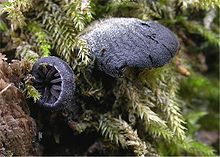| Resupinatus applicatus | |
|---|---|

| |
| Resupinatus applicatus | |
| Scientific classification | |
| Kingdom: | |
| Division: | |
| Class: | |
| Order: | |
| Family: | |
| Genus: | |
| Species: | R. applicatus
|
| Binomial name | |
| Resupinatus applicatus | |
Resupinatus applicatus, commonly known as the smoked oysterling or the black jelly oyster, is a species of fungus in the family Tricholomataceae, and the type species of the genus Resupinatus. First described in 1786 as Agaricus applicatus by August Johann Georg Karl Batsch,[1] it was transferred to Resupinatus by Samuel Frederick Gray in 1821.[2]
Description[edit]
The cuplike to convex fruit bodies of the fungus are 0.2 to 0.6 cm (0.1 to 0.2 in) in diameter, and grayish-blue to grayish-black in color. The dry cap surface is covered with small, fine hairs. The mushrooms have no stem, and have a firm but gelatinous flesh. The mushrooms produce a white spore print.[3]
Habitat and distribution[edit]
The fungus is saprobic, and grows on decaying wood.[4] It is widely distributed in North America,[3] Europe, and Australia.[5]
References[edit]
- ^ Batsch AJGK. (1786). Elenchus fungorum. Continuatio prima. p. 171.
- ^ Gray SF. (1821). A Natural Arrangement of British Plants. Vol. 1. p. 617.
- ^ a b Miller HR, Miller OK. (2006). North American Mushrooms: a Field Guide to Edible and Inedible Fungi. Guilford, Connecticut: Falcon Guide. p. 138. ISBN 0-7627-3109-5.
- ^ Emberger G. (2008). "Resupinatus applicatus". Fungi Growing on Wood. Messiah College. Retrieved 2010-12-08.
- ^ Fuhrer B. (2005). A Field Guide to Australian Fungi. Bloomings Books. p. 165. ISBN 1-876473-51-7.